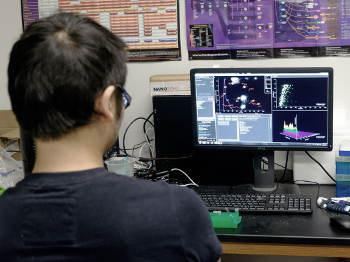Researchers in the Department of Chemical and Biomolecular Engineering at The Ohio State University (Columbus, Ohio, USA) are using Malvern Panalytical’ NanoSight Nanoparticle Tracking Analysis (NTA) to study extracellular vesicle yields from different cell culture lines.
 Researchers in the Department of Chemical and Biomolecular Engineering at The Ohio State University are using Malvern Panalytical’ NanoSight Nanoparticle Tracking Analysis (NTA).
Researchers in the Department of Chemical and Biomolecular Engineering at The Ohio State University are using Malvern Panalytical’ NanoSight Nanoparticle Tracking Analysis (NTA).
Dr Michael Paulaitis, Ohio Eminent Scholar and Professor Emeritus, and Prof. Jeffrey Chalmers have been leading the team characterizing the microvesicles. The work is part of a larger NIH-funded project headed by Prof. Thomas D. Schmittgen and Prof. Mitch Phelps in the Division of Pharmaceutics and Pharmaceutical Chemistry at the university. The project aims are to engineer cells to manufacture extracellular vesicles that target the liver, in order to deliver a specific microRNA species capable of retarding the growth of tumor cells.
Extracellular vesicles are released by almost all cell types. By transferring their molecular cargo, they have the potential to alter the function of recipient cells. The overall project includes the development of cell lines capable of producing large numbers of extracellular vesicles that have specific gene inclusions and a surface tag for targeting. NTA is being used to quantify extracellular vesicle particle numbers and yields in terms of their microRNA content and the presence of the surface markers. The ultimate aim of the project is to further the development of specific therapeutic options for hepatocellular carcinoma (HCC), the third most prevalent cancer in the world.
“The Malvern Panalytical NanoSight NTA system allows us to directly and reliably quantify extracellular vesicle yields from the cell lines under investigation, which is critical to this project,” said Dr Paulaitis. “We are also using the system to study the fusion of extracellular vesicles with synthetic nanoparticles, for the purpose of engineering the properties of the nanoparticles. We use a combination of the light scattering and fluorescence tracking functions of the NanoSight system to determine the proportion of fluorescently labeled nanoparticles that have bound to the extracellular vesicles. Having determined that we can quantify binding, the next step will be to scale up and apply NTA as a QC and process evaluation technique.”
The Malvern Panalytical NanoSight range of instruments uses Nanoparticle Tracking Analysis to characterize nanoparticles from 10 nm - 2000 nm in solution. Each particle is individually but simultaneously analyzed by direct observation and measurement of diffusion events. This particle-by-particle methodology produces high-resolution results for particle size distributions and concentrations, while visual validation provides users with additional confidence in their data. Both particle size and concentration are measured, while the fluorescence tracking mode can provide differentiation of labelled or naturally fluorescing particles.
The research at The Ohio State University is supported by NIH Common Fund Grant 1UH2TR000914-01, “Targeted delivery of microRNA loaded microvesicles for cancer therapy,” and by the NSF Nanoscience and Engineering Center for Affordable NanoEngineering of Polymeric Biomedical Devices.
To learn more about Malvern Panalytical’s NanoSight NTA systems go to www.malvern.com/nanosight.
Malvern Panalytical, Malvern Panalytical and NanoSight are registered trademarks of Malvern Panalytical
About Malvern Panalytical
Malvern Panalytical provides the materials and biophysical characterization technology and expertise that enables scientists and engineers to understand and control the properties of dispersed systems. These systems range from proteins and polymers in solution, particle and nanoparticle suspensions and emulsions, through to sprays and aerosols, industrial bulk powders and high concentration slurries. Used at all stages of research, development and manufacturing, Malvern Panalytical’s materials characterization instruments provide critical information that helps accelerate research and product development, enhance and maintain product quality and optimize process efficiency.
Our products reflect Malvern Panalytical’s drive to exploit the latest technological innovations and our commitment to maximizing the potential of established techniques. They are used by both industry and academia, in sectors ranging from pharmaceuticals and biopharmaceuticals to bulk chemicals, cement, plastics and polymers, energy and the environment.
Malvern Panalytical systems are used to measure particle size, particle shape, zeta potential, protein charge, molecular weight, mass, size and conformation, rheological properties and for chemical identification, advancing the understanding of dispersed systems across many different industries and applications.
Headquartered in Malvern Panalytical, UK, Malvern Panalytical has subsidiary organizations in all major European markets, North America, China, Japan and Korea, a joint venture in India, a global distributor network and applications laboratories around the world. www.malvern.com